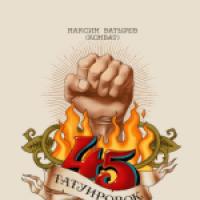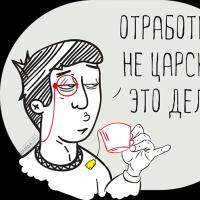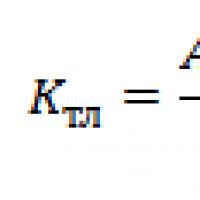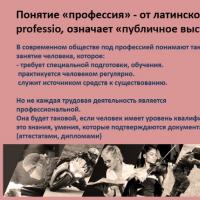Lesson on constructing a bird feeder. Summary of organizing and conducting classes on cognitive development in the second junior group “Bird feeder. Elena Alexandrovna Bezmaternykh
Tatyana Shagaeva
Summary of the lesson on designing a “Bird Feeder”
Goals: encourage design, cultivate a desire to take care of birds; learn to distinguish objects by size, learn to form in a circle, follow the teacher’s movements.
Materials and equipment: different types of grain (millet, seeds, etc.) in boxes, 5 liter bottle, empty milk cartons, pencil, scissors, awl, 2 bags, bird figurines (sparrow, tit, crow, magpie).
Progress of the lesson
Org. moment.
Children watch birds from the window.
The teacher talks about the life of birds in winter - It is necessary to take care of the birds in winter: feed them, do not offend them.
Main part. Construction.
Educator: We will make a feeder from a milk carton and a bottle. We will make windows in them so that birds can fly in and peck the grains.
The teacher makes a feeding trough together with the children.
Fizminutka
Educator: Now we’ll play. You will be sparrows and I will be your sparrow mother.
Mother sparrow calls her children
Fly to me quickly
We start today
We learn to fly
Hurry up and stand in a circle
Let's start
Walking in a circle - children “flapping their wings”, mother shows movement and moves away. While mom is watching, the children walk in a circle. Mom fell asleep and the sparrows scattered in all directions. Mom wakes up:
Chick tweet what a noise what a scream
Get into the circle quickly
And learn to fly again
Children stand in a circle and the game is repeated. Then mom bursts out again:
Dozed off for a minute
The sparrows got really naughty
I will strictly monitor you from now on
So that you grow up obedient sparrows
Educator: Our feeders are ready. Now let's pour the grains there. Which ones? Big and small. Now you will need to hang the feeder on a tree so that the birds can have a tasty lunch.
Publications on the topic:
The coming winter cold not only delights children with snow and adults with a festive mood, but also makes life more difficult for those birds who...
 Goal: formation of environmental culture; fostering a caring attitude and love for nature. Objectives: - Clarify and expand knowledge about winterers.
Goal: formation of environmental culture; fostering a caring attitude and love for nature. Objectives: - Clarify and expand knowledge about winterers.
In our kindergarten “Kalinka” in the Khimki urban district, along with traditional forms of interaction with parents (meetings, conversations,...
Wherever birds live: in forests and gardens, in meadows and fields, near water - their amazing voices are heard everywhere. But when winter comes...
For work we need: 1 package of any juice, a pencil, a glue stick, colored paper, colored cardboard, a paper knife and of course.
So the summer has flown by, pleased with the bright colors of the “Indian Summer”, and the time has come for late autumn. The sun rarely appears, it is cold.
Summary of organizing and conducting classes on cognitive development in the second junior group. Topic: “Bird feeder”
Program content:
-Introduce children to natural phenomena.
-Develop an interest in birds, recognize them by their appearance.
-Reinforce the concepts of “many” and “one”.
-Exercise children in constructing from Cuisenaire sticks.
-Develop observation and attention.
-Cultivate a caring attitude towards birds, a desire to feed them in winter.
Preliminary work:
-daily bird watching at the feeder while walking
Material:
- pictures of birds
- paper snowflake
- a drop of water
- Cuisenaire rods
Material:
You're winter-winter,
You came with the frosts.
White fluffy snow
Spinning in the air.
And the ground is quiet
Falls to lie down.
- Guys, snowflakes have come to visit us. They greet the children.
Children look at snowflakes.
-How many rays does it have? (a lot of)
-How many snowflakes? (three)
-I wonder why they came to us? (winter came)
Snowflake tells her story: “I live high in the sky. It's cold and lonely there, I often look at the ground, at the people. They are so kind and friendly and I wanted to be with them at least for one moment. A cold wind blew and I flew to you.”
Children with a teacher pretend to be snowflakes: spinning, “flying.”
-Guys. Snowflakes covered the whole earth with snow, it became so beautiful and white, but the birds became cold and hungry, it was difficult for them to find food under the snow.
Remember what birds we saw at our feeders?
-Look at this bird - I’m showing a sparrow
-What does a sparrow have? (head, beak, eyes, wings, tail, legs).
-What color are his feathers?
-What is the sparrow doing? - He pecks at grains and crumbs.
-How does he behave at the feeder?
The sparrow is brave, nimble, quickly flies up and flies away.
-Listen, I’ll read a poem about him.
I am a cheerful sparrow
Gray little thief.
I am careless, and talkative, and timid, chief, chief.
Midges serve as food for me,
Crumbs serve as food for me,
I am cunning and playful, fussy. Chiv, chiv!
My days are hard in winter,
-There is neither a crumb nor a bug,
That's when I'm silent, barely alive, chiv, chiv.
-How does the little sparrow scream? (chiv, chiv)
-That’s why we feed the sparrows in winter, we feel sorry for them. This is how the sparrow complains: “My days in winter are hard, there is not a crumb or a bug.”
The teacher shows a tit. The review goes the same way. Reads A. Barto's poem "Tit".
The nimble tit is jumping,
She can't sit still
Jump - jump, jump - jump,
Spun around like a cricket
I sat down for a minute,
She scratched her chest with her beak,
And from the path to the fence,
Tiri - tiri, shadow - shadow - shadow.
The teacher shows the bullfinch. The review goes the same way. Reads a poem.
In the garden where the finches sang
Today look-
Like pink apples
There are bullfinches on the branches.
-Well done! They remembered all the birds and told about them. Let's play. You will all be birds. I will say the words, and when you say “ay” you will fly away to the houses. The birds sit, peck and fly away.
A bird sat on the window:
Stay with us for a while.
Sit down, don't fly away.
The bird flew away - ah!
-What good birds! And now you guys again, sit down, calm down. Look what's in your envelopes? You need to put together a whole bird from the parts and say what kind of bird you have.
Reads R. Bukharev’s poem “Feeder”
Slowly, slowly the snow is falling.
A man walks quietly through the snow
In a hat and a fur coat,
He carries a red sled behind him.
The bird feeder in the sled turns yellow:
For kinglets, bullfinches and tits.
The snow is falling, falling, falling
Good luck to you, man!
So now you and I will go for a walk and feed the birds with crumbs and grains of seeds.
Target: Developing the ability to create a bird feeder from a LEGO set based on a diagram.
Tasks :
To form in children generalized ideas and knowledge about wintering birds;
Continue to learn how to combine parts in shape and color in construction, establish the spatial arrangement of parts;
Learn to maintain correct posture during class;
Strengthen your skillsdesign according to the scheme;
Develop the ability to work together without interfering with each other.
Preliminary work:
Examination of illustrations;
Reading books and stories;
Making riddles;
Observations;
Conversations;
Bird drawing, applique, modeling.
Equipment:
LEGO - constructor, presentation “Bird Feeders”, diagrams of feeders, illustrations of wintering birds.
Planned result:
Developed the ability to create a bird feeder from a LEGO set based on a diagram; children have developed generalized ideas and knowledge about wintering birds; children learned to combine parts in shape and color in construction; establish the spatial arrangement of parts; children learned to maintain correct posture; skills have been strengtheneddesign according to the scheme; learned to work together without interfering with each other.
Progress of the lesson:
Educator : Guys, please look at the screen. What do you see?
Children : Children's answers. (Tit, sparrow, crow, etc.).
Educator : Right, but what can you call these birds in one word?
Children : Children's answers. (Wintering birds).
Educator : Of course, these are wintering birds, well done. What do you think, with the arrival of winter, where and how do birds get their food?
Children: Children's answers.
Educator : What do you guys think, what is worse for birds than cold or hunger?
Children: Children's answers.
Educator : That's right guys! The worst thing for birds is HUNGER in winter. Can you and I somehow help our little friends?
Children: Children's answers.
Educator : Certainly! We will make feeders. And I have this feeder.
(The teacher shows the children a feeder made from LEGO construction sets.)
Educator : Now I’ll tell you and show you what kind of feeders you can make from LEGO construction sets.
Demonstration of the presentation “Bird Feeders”.
Physical education minute. Finger gymnastics.
We made a feeder.
We opened a canteen.
Sparrow, bullfinch - neighbor,
This will be your winter lunch!
Visit on the first day of the week
Two tits have flown in,
And on Tuesday - bullfinches,
Brighter than the morning dawn!
Three crows were on Wednesday
We weren't expecting them for lunch.
And on Thursday from all over the world -
Ten greedy sparrows
On Friday in our dining room
The pigeon was enjoying porridge.
And on Saturday for pie
Seven forty arrived
Educator : - And now I suggest you guess the riddles about wintering birds, and we will attach pictures with the answers to the feeder.
I catch bugs all dayI eat bugs and worms.
I’m not leaving for the winter,
I live under the eaves.
Tick-tweet! Don't be timid!
I'm experienced... (Sparrow)
Been chattering since the morning:
Let's go! Let's go!
What time is it? such a hassle for everyone,
When it cracks. (Magpie)
The color is greyish,
Habit - thieving,
Hoarse screamer -
Famous person.
Who is she?.. (Crow)
Who's jumping and rustling there?
Does it gut pine cones with its beak?
“Cool! Cool! Cool!” sings with a whistle. (Crossbill)
Northern guests
The rowan berries are pecking,
So elegant and bright.
There are tufts on the heads. (Waxwings)
Guess what kind of bird
He is afraid of white light.
Crochet beak,
Piglet eyes,
Eared head. This is (Owl).
The back is greenish,
The belly is yellowish,
Little black cap
And a strip of scarf. (Tit)
Who is wearing a bright red beret,
In a black satin jacket?
He doesn't look at me
Everything is knocking, knocking, knocking. (Woodpecker)
Blackwing,
Redbreast
And in winter it will find shelter:
He is not afraid of colds -
The first snow is here! (Bullfinch)
I'm the only bird, I must admit,
In the heat, frost and snowstorm
Move along the trunk
I can do it with my head down. (Nuthatch)
Educator : Well done. Look how many birds flocked to our feeder. Now let's start making our feeders.
Educator: Now let's sit down in pairs.
Children sit in pairs, each pair is given a LEGO set and feeder diagrams. Children begin making feeders.
Educator : Guys, look what wonderful feeders we have made! You all did a very good job. You can also encourage parents to make feeders at home and hang them in their yard.
Summary of a design lesson in the junior group “Bird Feeder”
Objectives: 1. Expand children’s understanding of wintering birds, how and what they eat in harsh winters.
2. Teach children to build a bird feeder house based on the model; analyze the sample, highlight its main parts (base, walls, roof), explain their functional purpose.
3. Learn to build a feeder-house from three types of building materials (brick, triangular prism, plate); connect parts horizontally and vertically in a vertical structure; correctly connect parts of the structure into a whole building; visually control the correct execution of the sample.
Materials and equipment: pictures of birds and bird feeders; bricks (2 pcs.), triangular prisms (2-3 pcs.), a thin square plate (1 pc.) or cardboard for each child.
Organizing time.
Together with the children, watch the birds at the feeder from the window, read a poem by N. Nishchev
How many birds are there for our feeder?
Has it arrived? We'll tell you.
Two tits, a sparrow,
Six crows and doves
Woodpecker with variegated feathers
There were enough grains for everyone.
Progress of the lesson:
The teacher shows the children pictures of birds and asks them to name them.
Questions for children when looking at the pictures:
Who is this? (This is a bird.)
- What does she have? (The bird has a head, body, tail, beak, legs, feathers, wings, eyes.)
-What are her eyes like? (Small, black.)
- What head? (Round, small.)
- What body? (Oval, long.)
- What is the bird’s body covered with? (With feathers.)
- What kind of beak does it have (legs, tail)?
Then the teacher tells what birds eat, how difficult it is for them in the cold winter, shows pictures of bird feeders, and invites the children to make such feeders themselves.
Questions for children:
What do birds eat? (Grains, seeds, bread crumbs.)
- How do they eat? (They peck.)
-What do they eat for food? (Beak.)
2. The teacher shows the children a sample of the design of the feeder house (from two bricks and two prisms), invites them to examine it carefully: highlight the main parts of the feeder (side and top) and select the necessary parts of the building material for constructing each of them, explains how to connect the parts in vertical design.
Questions for children when looking at the sample:
What is this? (Feeder.)
- What does the feeder have?
- How many walls does the feeder have?
- What are the walls made of?
- Where should we start building?
- Is this brick standing or lying?
- How should the bricks be placed? On the wide or narrow side?
The teacher builds a bird feeder, explaining: “The main thing is to position the wall bricks correctly. One brick should be placed exactly opposite the other. One prism (roof) must be carefully placed on top of the walls, then another prism (the second part of the roof).” The teacher teaches how to carefully work with parts of building materials. “Now build the same feeders as mine.”
3. Physical education minute
"Birds"
Birds sitting in a nest
And they look at the street.
They want to take a walk
And everyone flies quietly.
(The children “fly away” - they flap their arms like wings.
4. Independent work of children. The teacher guides the children’s practical activities and encourages them to make statements that accompany the work process.
Questions for children during work:
Take this brick. Show me. What kind of brick is this? (Long.)
- Sasha, what did you take?
- Did you lay or install a brick (roof)?
-Did you put the roof down carefully?
- Did you put the bricks opposite each other?
- What did you do?
- Did you get a feeder?
- What will you take? (Brick, roof.)
-Will you lay or place a brick?
-What are you putting the roof on? (On bricks.)
- Where are the walls of the feeder? Show me, Lena.
- Tell me, Lena, what is this? (This is a feeder.)
- What are you doing, Masha? (I'm building a feeder.)
- What is Olya doing? (She is building a feeder.)
- What did you do, Vanya? (I put a brick. I put a plank.)
5. Reflection.
Look what kind of feeding houses we have made.
- What kind of feeder do you have, Masha? (I have a big one.)
- What kind of feeder do you have, Vanya? (I have a small one.)
- How many feeders did we have? (A lot of.)
BDOU kindergarten "Kolobok"
Oryol Region
P.Dolgoe
Summary of GCD in the senior group
"Making bird feeders"
Compiled by: Anisimova Valentina Petrovna
Educator
2016
Target: Creating conditions for children to become familiar with wintering birds and making bird feeders from waste material.
Tasks:
Educational:
To form children's understanding of wintering birds: their appearance, nutrition, and habitat features in winter conditions.
Educational:
Promote the development of interest in the animal world. Expand and activate children's speech reserve.
Educational:
Cultivate responsiveness, encourage the desire to care for birds.
Integration of educational areas: cognitive development, speech development, artistic and aesthetic development, physical development.
Preliminary work:
Bird watching on a walk;
Conversations: “Small titmouses”, “Our feathered friends”;
Reading fiction: M. Gorky “Sparrow”, S. Marshak “Where did the sparrow have lunch?”, G. Skrebitsky “Titmouses have appeared”, V. Bianki “It’s cold, there’s hunger in the forest”, A. Yashina “Feed the birds in winter”.
Modeling on the theme: “Our feathered friends.”
Learning proverbs about birds.
Material and equipment:audio recording of A. Vivaldi’s album “Winter”, presentation “Winter Forest”, presentation “Wintering Birds”, hoops of three colors, pictures - diagrams for differentiation into migratory, wintering, and nomadic birds, pencils, scissors, waste material (boxes of under juice, kefir), threads.
GCD move:
1. Organizational point:
An audio recording of a titmouse's stump sounds.
Educator: Determine what sounds you hear? What did the titmouse tell you?
2. Conversation on the topic:
1) posing a problem situation: “Why can’t you hear birds singing in winter?”
Educator: -Guys, today I invite you to go to the winter forest.
View the presentation “Winter Forest”.
Look at the trees around: white caps of snow lie on the green paws of spruce and pine trees, and there is silence all around. I can't hear anything. Why so quiet?
-Tell me, please, what birds live in the forest in winter?
- What birds live next to people in the city?
-What birds come to us with the onset of winter?
3. Didactic game “Make no mistake”
(Hoops of three colors are laid out on the table)
Educator: Birds are migratory, nomadic, and wintering.
Arrange the birds: in a blue hoop - wintering birds, in a yellow hoop - migratory birds, in a green hoop - nomadic birds.
4. Didactic game “Guess who?”
Educator: -Who can you tell about?
-Cunning, dexterous, resourceful...(crow)
-Yellow-breasted, dexterous...(tit)
-Brave, resilient... (sparrow)
- Stubborn, motley... (woodpecker)
-Predatory, big-headed, silent...(owl)
-Red-breasted, lively...(bullfinch)
-Bright, cheerful, friendly...(waxwings)
5.Riddles:
Educator: - Guess my riddles:
1) Black-winged, red-breasted will find shelter in winter. He is not afraid of a cold, with the first snow right there! (Bullfinch)
2) What kind of bird is not afraid of frost, even though there is snow everywhere in its nest? (Crossbill)
3) I eat bugs and worms, I don’t fly away for the winter. Under the eaves, in a gray feather coat and in the cold, I am a hero. (Sparrow)
4) Who is wearing a bright red beret and a black satin jacket? He doesn’t look at me, he keeps knocking, knocking, knocking! (Woodpecker)
5) Northern guests peck rowan bunches, are the crests on their heads so elegant and bright? (Waxwings).
6) Sleeps during the day, flies at night, scares birds in the forest? (Owl)
-Why are birds afraid of an owl?
-What helps an owl hunt at night?
6. Game "Fourth wheel":
Educator: - Name what is superfluous here:
tit, starling, magpie, pigeon;
woodpecker, tit, sparrow, rooster;
magpie, tit, bullfinch, sparrow;
sparrow, tit, crow, owl.
7. Proverbs:
Educator: -What proverbs about birds do you know?
“The nightingale and the crow live in the forest, but they sing their songs differently,”
“Wherever a bird flies, it knows its nest”
"A big bird needs a big nest"
"Every swallow praises its nest"
“Every bird flies to its flock.”
8. Physical education minute:Outdoor game "Owl" (2 times).
9. Teacher’s story on the topic: “Who eats what”
Educator: -Guys, how can we help our feathered friends?
-Tell me, what do birds eat in the summer? (insects)
-And in winter?
-Is it difficult for them?
- Of course, it’s hard for birds in winter. It is especially difficult to find food during snowfalls, blizzards and severe frosts. In such weather, birds often go hungry and even die from starvation, and therefore approach people's homes. You and I must help our feathered friends survive the winter.
Seeds of various plants are suitable for feeding birds: hemp, sunflower, melon. pumpkin, watermelon, many weeds. But only sparrows and buntings peck oats and millet. Tits are very fond of pieces of unsalted lard.
10. Construction from waste material(juice boxes, kefir boxes)
Children consider and suggest ways to make feeders.

Educator:
-There are boxes on your table. We will use them to make feeders.
-What are threads for? (to tie a loop).
-Why do you need to cut a hole? (so that the birds get inside the feeder).
11.Repetition of safety precautions when working with scissors.
12. Making feeders.
13. Finger gymnastics:
Educator: -Guys, we need to stretch our fingers.
I decided to count the crows: (Children alternately hit fist against fist and
One two three four five. palm on palm)
Six-crow on a post
Seven is a crow on a trumpet,
Eight sat on the poster,
Nine feeds the crows...
Well, ten is a daw.
That's the end of the counting! (Clench and unclench fingers) 14.Result:
Educator: -Well done! Everyone did it. Look how many feeders there are. Now we will go for a walk and hang our feeders.
During a walk, a child reads T. Kulakova’s poem “Feeding Trough”
Birds flew into our yard in winter,
The birds started talking to us.
The sparrow chirped, looked for grains,
The crow croaked, the dove cooed,
The tit tinkled and the bullfinch whistled,
The waxwing on the branch also sang a song.
Our poor birds are hungry in winter,
There are few grains, crumbs, it is difficult to feed. We made a feeder. They attached it to a birch tree.
 Professional and personal qualities of a sales manager
Professional and personal qualities of a sales manager How to quit without working for two weeks, step-by-step instructions Why you need to work for 2 weeks when leaving
How to quit without working for two weeks, step-by-step instructions Why you need to work for 2 weeks when leaving Advances of modern natural science
Advances of modern natural science Entrepreneurial environment and its structure Entrepreneurial environment as a system of relations
Entrepreneurial environment and its structure Entrepreneurial environment as a system of relations Theoretical aspects of analyzing the creditworthiness of an enterprise
Theoretical aspects of analyzing the creditworthiness of an enterprise Violation of the period of temporary import of goods
Violation of the period of temporary import of goods Is an ecologist a profession of the 20th century?
Is an ecologist a profession of the 20th century?